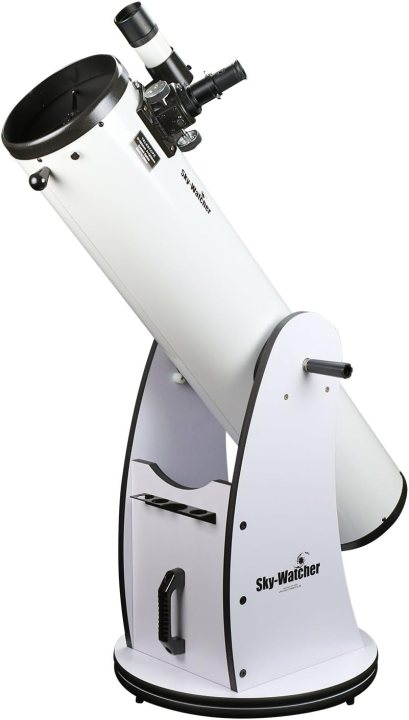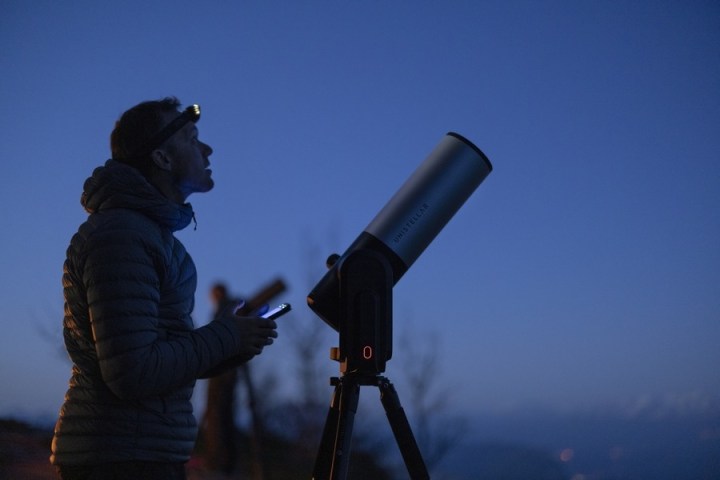
There’s nothing like an evening spent outside under the stars to feel the wonder of nature, and a telescope can enable you to see objects in the night sky in stunning detail. From peering at the craters on the moon to seeing the rings around Saturn, or even observing a stunning nebula, using a telescope is a great joy for many people. But if you’re new to the world of amateur astronomy and are looking to get your first telescope, there are a huge array of options that you can choose from.
We’ve rounded up some of the best telescopes for beginners, giving you suggestions for where to get started when you want to get into stargazing. Whether you’re looking for a fun activity to share with your kids, a way to take gorgeous photos of the night sky using your smartphone using one of the best smart telescopes out there, or a portable option you can take with you when you’re out on a hike, there’s a beginner-friendly telescope option available to meet your needs.
The Best Telescope for Beginners in 2024
-
Buy the
Unistellar eVscope eQuinox
if you want an app-based telescope. -
Buy the
Celestron StarSense Explorer LT 80AZ
if you want an all-round beginner telescope. -
Buy the
Orion FunScope 76mm Tabletop Telescope
if you want a telescope for kids or the family. -
Buy the
Celestron Inspire 100AZ Refractor Telescope
if you want an entry-level telescope. -
Buy the
Sky Watcher Classic 200 Dobsonian
if you want a home telescope
Unistellar eVscope eQuinox
Best app-based telescope for beginners
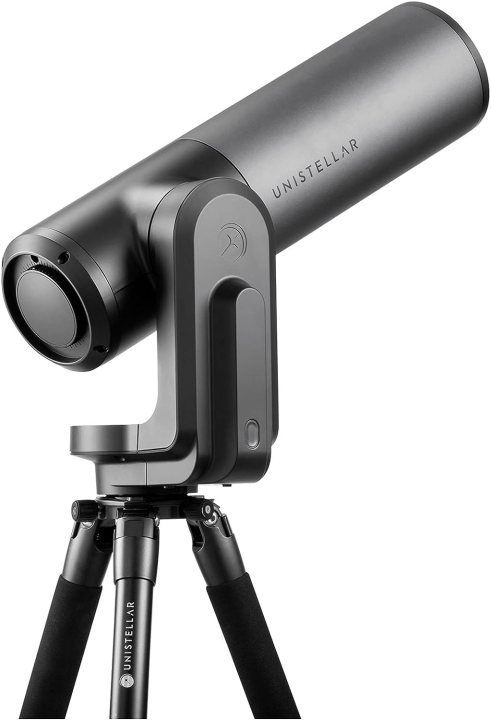
| Pros | Cons |
| Dedicated app | App maybe fiddly for some |
| Easy for beginners | Expensive |
| Good for areas with light pollution |
Celestron StarSense Explorer LT 80AZ
Best all-around telescope for beginners
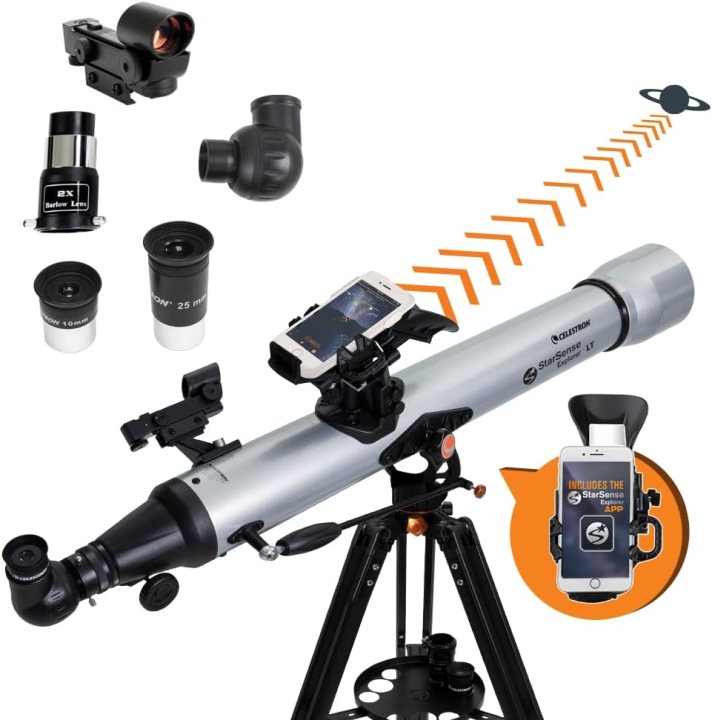
| Pros | Cons |
| Dedicated app | Not the most powerful |
| Easy set up | |
| Everything you need |
Another option for a telescope with a handy app is the Celestron StarSenese Exoplorer LT 80AZ. This 80mm refractor telescope is perfect for viewing objects within the solar system like the Moon or planets Mars or Saturn, and seeing some bright nearby nebulae as well. The telescope comes with a mount for your smartphone which you can use to track star patterns in the sky, helping you to calculate what you are looking at and to point to particular objects you want to explore. The app works with both iOS and Android smartphones.
The telescope comes with handy extras like a full-height tripod, a finderscope in case you don’t want to use your phone or don’t have internet access, two eyepieces, and a 2x Barlow lens. It’s a good value package making it easy for beginners to get set up and start observing nearby objects. It’s not too heavy and is a great option for someone looking for an all-in-one package to get started, though it won’t be suitable for looking for more faint or distant objects.
Orion FunScope 76mm Tabletop Telescope
Best telescope for kids and families
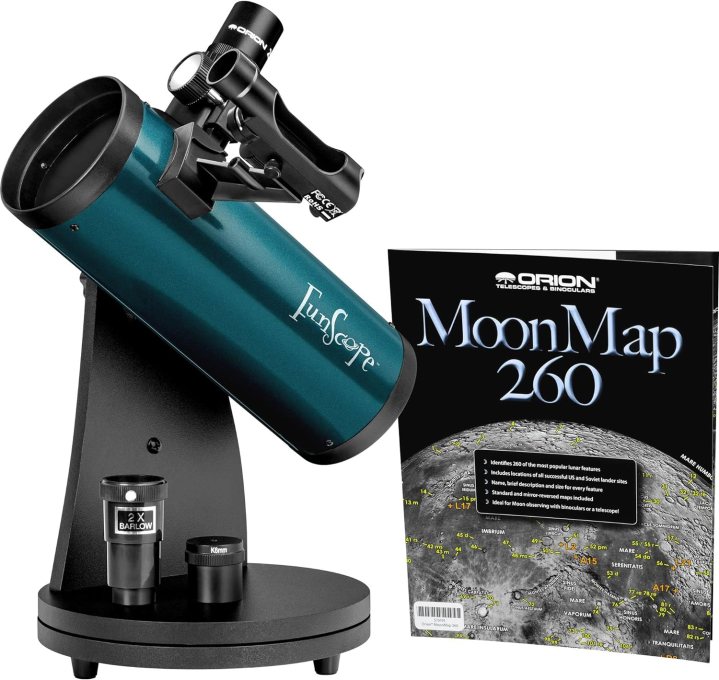
| Pros | Cons |
| Affordable price | Not suited for looking at other distant objects |
| Tabletop function | |
| Great for observing the moon |
If you’re interesting in getting into stargazing with younger children, then a tabletop telescope can be a great choice. These don’t require a tripod and are often lightweight, so they’re good for quickly setting up in the back yard or on a camping trip. This 76mm lens telescope is perfect for looking at the moon in detail, and comes with a guide to the many craters you can see there. The package also includes a 2x Barlow lens and two eyepieces, plus a finderscope.
You might be able to spot some other objects in the sky too, like some of the brighter planets or nearby nebulae, but this isn’t designed for power so don’t expect crisp views of distant galaxies. But it’s great for an easy way to get kids interested in space and to teach them about the moon in particular, all for an affordable price that makes this a fun tool to share with the family.
Celestron Inspire 100AZ Refractor Telescope
Best telescope for entry-level astronomers

| Pros | Cons |
| Decently powerful | A bit heavy for carrying long distances |
| Smartphone adapter | |
| Easy setup |
How We Chose These Telescopes for Beginners
When it comes to choosing a telescope, especially if you’re a beginner, there are a ton of factors to consider. A lot depends on how you’re planning to use your telescope — in your backyard, or while out camping, or with kids, or in a group — and also what kind of objects you’re hoping to observe. Even a non-powerful telescope will allow you to observe the moon and pick out features on its surface like craters, and most should be able to see the brighter planets like Mars and Venus as well. But if you want to observe deep sky objects like galaxies and nebulae, you’ll need something more powerful.
Budget
For most beginners to a hobby, when it comes to choosing an entry-level telescope then budget is going to be at the front of their minds. You can find beginner-aimed telescopes from below $100 to over $1,000, so there’s a big bracket to chose from. While it is of course possible to pick up a bargain, especially during sales, often when it comes to this kind of technology, you get what you pay for. So a cheap option might be fine for some casual looking at the moon with your kids, but if you’re hoping to get more seriously into the hobby then you may need to shell out more.
Format
When you think of a telescope, the first thing you imagine is probably a tripod mount. And these are still the most popular format for most users, with a tube attached to an adjustable tripod. These can be a bit fiddly to set up, but they are flexible and usually fairly lightweight. You’ll also find altazimuth mount systems which allow movement vertically and horizontally, making them easier to point. Other types are tabletop, which don’t require a tripod and can be placed on a flat surface, or Dobsonian telescopes which are larger and heavier than other types. You should check the weight of a telescope if you’re planning to take it out on hikes with you, as some can be easily carried while others you wouldn’t want to lug around.
Power
There are several numbers you need to pay attention to when picking out a telescope. First there’s aperture, which is the size of the mirror or lens, with a larger aperture able to capture more light and therefore a sharper image. To view those distant and faint objects, you’ll need a larger aperture. The magnification is important too, which is determined by the focal length and its relationship to the aperture. A more magnifying telescope lets you see smaller objects, but without a large enough aperture they might appear blurry. You’ll also find different types of telescope, mostly commonly refractor and reflector. The difference is whether there are a lens and a mirror or two mirrors, with the reflector type generally having higher image quality.
Technology and smartphone integration
Many modern telescopes now come with smartphone features and apps which can help new users learn the ropes. Your smartphone can help you to aim your telescope and identify objects to observe, as well as to take photographs if there is a mounting system included in the telescope. But, as often in life, more technology doesn’t always make for a better experience. Some people love the high tech assistance, while others prefer the simplicity and purity of a manual telescope. Ask yourself if you’re someone who loves to play with apps and new tech, or whether you prefer a more leisurely and hands-on experience when you’re learning.
This article is managed and created separately from the Digital Trends Editorial team.
